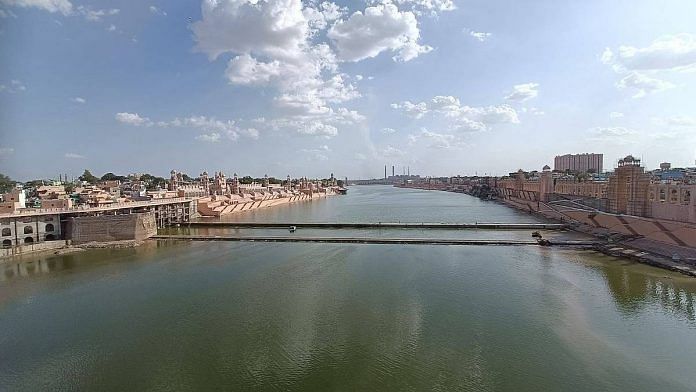Indian rivers are currently facing three major challenges—an age-old law, misuse of water resources, and continuous pollution. In 2022, 311 river stretches were polluted in 279 rivers across 30 states and Union Territories. With growing social and economic aspirations, concerns related to water availability and quality of Indian rivers are increasing too.
The 19th World Rivers Day this year aptly focuses on raising stakeholders’ awareness about the benefits and services provided by rivers, their degradation, and the need to make them healthy again. The timing is perfect considering the latest United Nations (UN) assessment, which highlights that 2.4 billion people live in water-stressed countries and thus the need to sustainably manage their limited water sources.
From the Ganga in the north to Cauvery in the south, Indians have been culturally attached to rivers through generations. Currently, the country is witnessing economic growth with an aim to become a $5 trillion economy by 2025 in a rapidly warming world, which will exponentially increase demand for all natural resources, including water.
Analysis of the Council on Energy, Environment and Water (CEEW) highlights that 11 out of 15 major river basins in India will experience water stress by 2025, a condition where the per capita annual renewable water resource availability will be below 1,700 cubic metres. The realisation of India’s economic ambition will depend on how well it manages its water resources as it is an important input for energy, food, and industrial production. We highlight three major challenges to managing river water in India, how they are dealt with, and the scope for improvement.
First, the governance of inter-state rivers. Most of the rivers in India are shared by two or more states. Though as per the Seventh Schedule of Article 246 of the Indian Constitution, states have full control over water resources within their jurisdiction, their rights are subject to any law enforced by Parliament regarding the regulation and development of inter-state rivers.
Given that the water stress in river basins is resulting in a deadlock between riparian states over water sharing, the Central government will continue to play an important role here. However, the Inter-State River Water Disputes Act of 1956 is dated and needs revision. An amendment was introduced and passed by the Lok Sabha in 2019 but it’s yet to be taken up for discussion in the Rajya Sabha. Importantly, the amendment seeks to replace the multiple tribunals set up by the Centre for inter-state water dispute adjudication with a single tribunal and set strict timelines for decisions. The passing of this amendment needs to be prioritised.
Water-saving practices
Managing the existing misuse of river water is the second challenge. Of late, several initiatives have been undertaken in India for judicious and efficient use of river water for various purposes including the adoption of the piped water distribution network and micro-irrigation systems for agriculture in canal command areas. As per CEEW analysis, even under conservative estimates, about 20 per cent of currently used irrigation water could be saved by 2050 if water-saving practices such as micro-irrigation systems are adopted.
In the industrial sector, especially the thermal power plants that extract substantial amounts of freshwater for cooling purposes, there are environmental regulations in place to limit water consumption to 3 cubic metres per megawatt-hour of electricity generation for plants installed after 1 January 2017. Actions under Mission LiFE (Lifestyle for Environment) have been suggested in the domestic sector to make a behavioural shift towards water saving at the household level. For continuous assessment of the water use and saving potential across sectors, a system of proper water accounting needs to be adopted. It would estimate water availability, withdrawals, actual consumption, conveyance and other non-beneficial losses, and water use efficiency over time.
The information generated through water accounts will help water managers decide on the judicious withdrawal of water from various sources, including rivers.
All hands on deck
The third big challenge is river pollution. While contaminants from non-point sources such as runoff from agricultural areas are an issue, untreated wastewater from urban areas carrying a mix of sewage and industrial effluents that end up in the river during non-monsoon months is a major concern. As per our estimates, by 2050 about 35,178 million cubic metres of domestic wastewater will be generated from urban areas in India.
As of 2021, we have the capacity to treat just 44 per cent of the sewage of cities. While there are several ongoing policy initiatives such as the Namami Gange programme and National River Conservation Plan, wastewater management including treatment and reuse needs to be scaled up. This will require making wastewater treatment and reuse projects financially viable—by providing performance incentives to municipalities and private operators and utilising low-cost, energy efficient treatment technology advancements.
The transition from water stress towards water security in India requires thinking about the linkages between water, energy, food, and livelihoods at the river basin scale. To achieve this, the active participation of all the stakeholders, including communities, is crucial. Rivers don’t stop at borders, ensuring their flow requires all hands on deck.
Nitin Bassi is Senior Programme Lead and Suparana Katyaini is the Programme Lead with the Council on Energy, Environment and Water (CEEW).



